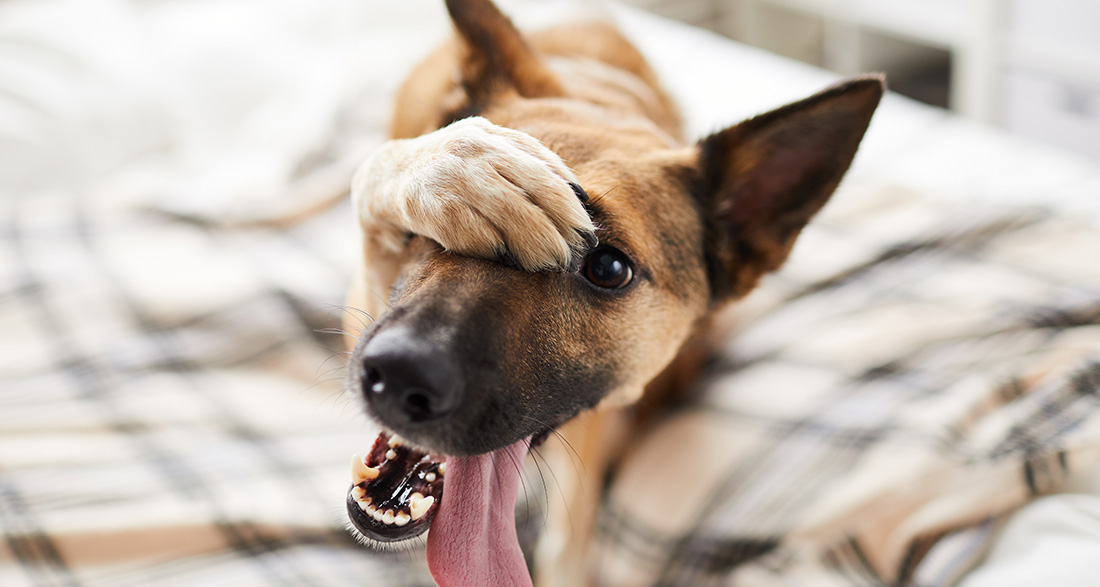Who is this trick for?
This adorable trick is for anyone who enjoys experimenting and practicing with their dog. Additionally, the Peekaboo trick makes for a superb photo opportunity. Physically, the trick is not very strenuous; however, only dogs without severe joint problems (e.g., in the hips) should perform it. As the execution is repeated frequently during practice, a higher load on the hindquarters should be possible without health issues. If your dog is fit and healthy, there’s nothing stopping you from teaching this trick. Conversely, if your dog has health limitations, you can try many other tricks in the series, such as “Speak” or “Rest Head.”
How do I start?
For this trick, your dog should already be proficient in giving both paws. Alternatively, you can use the “begging” command as a basis for building this trick. You don’t need a clicker for this trick as a training tool, as your hands should be free, and you can confirm and praise at the right moment without it. Grab your dog, some small training treats, and choose a quiet training environment.
Step 1
The Peekaboo trick consists of two parts. First, your dog will learn to support itself with both paws on your forearm. Start by sitting in front of your sitting dog and, instead of offering your palm, extend your arm. Your dog should simply place its paw on top, which it will probably do. For this, praise and give a treat. While one paw is on your arm, now also request the other one so that both paws are on your arm, and your dog is essentially sitting on its hindquarters. This might be challenging for him, so reward any attempts that go in the right direction.
If your dog already knows the “beg” or “sit up” trick, where he remains seated with his rear on the ground and doesn’t stand on his hind legs, you can build on this signal. Support and provide stability with your arm. The initial goal is for your dog to have both paws side by side on your forearm, sitting upright. Repeat this step until your dog reliably places both paws on your arm when you offer it. If you want, you can now introduce a verbal cue for this behavior, such as saying “Paws up” just before offering your arm.
Step 2
Is the starting position working, and your furry friend understands what you want from him? Great! Repeat this step a few times to give him confidence, and then move on. In the next step, your dog should stretch his head between his front legs and look down under your arm. To do this, lure his head down to the correct position with the treat and reward him if he stays in that position and doesn’t take down the front paws. Again, make several repetitions. Quickly phase out the treat as a lure and use the empty hand to entice your dog.
Continue to reward him for correct execution with a piece of food. To ensure that your dog keeps his head down for as long as you want, you can already introduce your release cue at this point. Say your release word just before rewarding your dog with the treat, and he will naturally release. Gradually, you can extend the duration step by step.
Step 3
Once the sequence works well, introduce the verbal cue “Peekaboo” so that your dog can associate it with the trick. Say your chosen cue, e.g., “Peekaboo,” just before making the luring movement with your hand. Gradually reduce the hand gesture, making it smaller each time until your dog responds to the verbal cue alone.
Step 4
In the final step, focus on reinforcement. If the routine works flawlessly when you sit or squat in front of your dog, hold out your arm (“Paws up”) and say “Peekaboo”? Fantastic! Now, try some variations, like holding your arm while standing. It’s also cute if your dog is standing, and you simply raise your arm a bit higher. This works well in the woods on a branch or tree trunk, if it’s conveniently placed for your dog to look underneath.
The more you repeat the trick, the better your furry friend will understand the sequence, and you can capture wonderful photos. Take your time for practice and don’t pressure yourself or your dog if it doesn’t work immediately. The main thing is that you both enjoy the shared training because that’s the most important thing in trick training.
Tip:
If you have a large dog that places half its weight on your arm, the training quickly turns into a challenging arm workout, but it can also get wobbly. In this case, it’s helpful to support your hand on a chair or bench to find more stability and relieve your arm.


